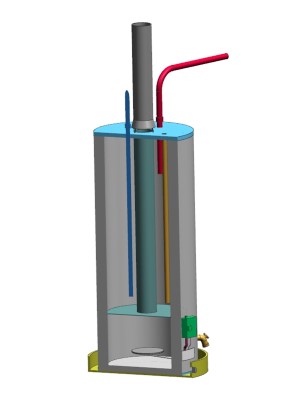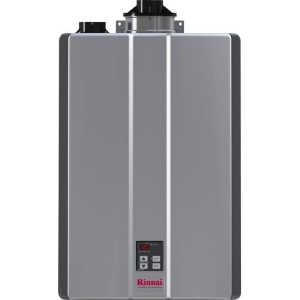- Home
- Gas Water Heaters
- Water Heater Venting
Selecting the Best Venting Option for a Gas Water Heater
Find out how to select the best water heater venting option for your safe, reliable, and economical home water heating.
Explore the differences between atmospheric, power-vent, and direct-vent systems.
Every natural and propane gas water heater needs an adequately designed venting system to safely remove the flue gases (byproducts of combustion) outside and draw the fresh air for the proper gas combustion.
The venting system must be correctly sized to handle the total BTU input of the water heater.
The flue gases contain mainly water vapor and carbon dioxide, which is acidic, so for safe removal from the heater, they are moved outside through the metal flue, chimney, or side vent.
Depending on the location of the new gas water heater, different venting systems should be considered for the most economical, safe, and reliable water heating. Venting flexibility is very important when selecting a suitable model, so buy a water heater that allows you various installation options.
Types of venting systems
There are three the most used venting systems in residential water heating: atmospheric, direct-vent, and power-vent.
They use flue ducts or a chimney to move the exhaust gases from the water heater to the outdoors. Depending on the venting system, flue ducts can be metal or plastic.
Atmospheric venting
 Gas water heater
Gas water heaterThe most common type of gas water heaters is the atmospherically vented type that uses a natural way (buoyancy) to move the flue gases from the unit out. The atmospherically vented heater uses a vertical metal pipe, sometimes connected to the chimney. The hot flue gases rise naturally through the draft hood and flue pipe and out in the atmosphere (natural convection). Combustion air is drawn from inside the house.
The efficiency of the atmospheric vents increases with the longer ducts and temperature of the exhaust gases.
The advantage of using this type of venting is the unit's low cost, installation, and operation. Atmospheric-vent water heaters are also the cheapest. They can operate without electricity.
Direct venting
Direct-vent water heaters are designed with a sealed combustion chamber, and they mostly use the horizontal flue pipe directly through the external wall and out. They do require zero tolerance for the proper and safe transfer of the flue gases.
Direct vent models can use a separate vent pipe or double-wall vents (coaxial) to draw the fresh air in, so they can be installed almost anywhere.
Due to their air-tight design, direct vent heaters provide more flexibility during installation than the above atmospheric type, and are quieter than power-vent heaters that utilize electric fans.
Sealed combustion is particularly useful if the water heater is installed near flammable and corrosive chemicals and other products. Direct vent heaters are not subject to the effects of backdrafting.
Power venting
Power-vent water heaters use a mechanical fan to move the byproducts of combustion to the outdoor atmosphere. They are expensive but bring lots of flexibility during the installation.
The venting system can be installed vertically, horizontally and the unit can be far away from the point of termination. Some water heaters have long vent pipes, up to 150 feet in length. Most of the time, combustion air is drawn from inside the home.
Since the byproducts of combustion are acidic and have a high temperature, both tank-type and tankless water heaters must use metal or stainless steel venting pipes. However, condensing units, due to the lower temperature of the exhaust gases, can use pipes made of different and cheaper materials such as PVC and CPVC, which is also easier to install.
Water heaters with power venting are recommended for tightly built homes and homes with no chimney, where a good natural draft is hard to establish and increase energy efficiency.
Power vented heaters are not recommended for installation close to the living room due to the noise a fan produces. They are electrically dependent as the electric fan has to be powered, so they must be installed nearby the electrical outlet. Such heaters must be placed in a room with adequate airflow. They cost more than other types.
- Find Plumbers In Your Area -
Venting layout
The venting system of the gas water heaters might consist of one or two pipes. The two-pipe system can be further divided into the concentric (pipe inside the pipe) system, and a system with two separate pipes. The vents can run horizontally, vertically, or combined.
One-pipe venting water heater, such as the above atmospheric type, utilizes one pipe for transferring the flue gases out while the air for combustion is brought from the surrounding atmosphere to the combustion chamber.
There are also water heaters, such as tankless outdoor models, that do not require venting, as they are installed outside.
All the tank-type heaters are designed for indoor use only.
According to the experts, when choosing between venting types, it all comes down to your home and the location of the heater.
Venting problems
One of the common issues associated with the water heater venting system is backdrafting. Backdrafting is a situation when exhaust gases, instead of exiting outside, end up inside the house. This problem is often found in atmospheric-vent models because the draft method is not reliable.
What can cause backdrafting is poor vent design and insufficient draw, obstructions in the flue pipe, or outside pressure. One frequent installation mistake includes insufficient pitch upward and bends close to the draft hood, so hot gases cannot rise quickly.
The most apparent symptoms of the backdrafting are:
- Melted plastic of the water inlet/outlet rings, located on top of the water heater and close to the draft hood.
- Exhaust gases can condense at the top of the heater and cause corrosion.
- Heavy condensation can also occur on the nearby cold water pipes.
To prevent the problem, do the following to check for the proper draft at a water heater:
- Close all doors and windows.
- Turn off the furnace if it shares the same chimney.
- Start the heater and let it run for some time before the test.
- Put your hand close to the draft hood, and if you feel warm and moist air coming out, the water heater is backdrafting. You can also use a mirror. Hold it close to the draft hood, and see if it is fogging up. The cobwebs can also give you a visual indication of a problem. Alternatively, you can use a matchstick to see if the smoke is pushed away from the hood.
Installation tips
If you require professional assistance, contact your local water heater expert! Get FREE estimates here!
Keep in mind that water heaters must be installed according to the manufacturer's instructions and local or national codes and regulations.
Gas water heaters are usually installed in the utility or mechanical room, garage, closet, confined or unconfined space. Depending on the vent type and provisions for combustion, ventilation air must be provided in the recommended volume.
For the proper operation, venting systems, including the vent pipe, flue baffle, and draft hood, must be inspected and cleaned at least once a year.
Proper venting is essential for the safe operation of the gas water heater as the incorrectly designed system can lead to incomplete gas combustion, problems, and injuries, including death.
Related
- Home
- Gas Water Heaters
- Water Heater Venting



